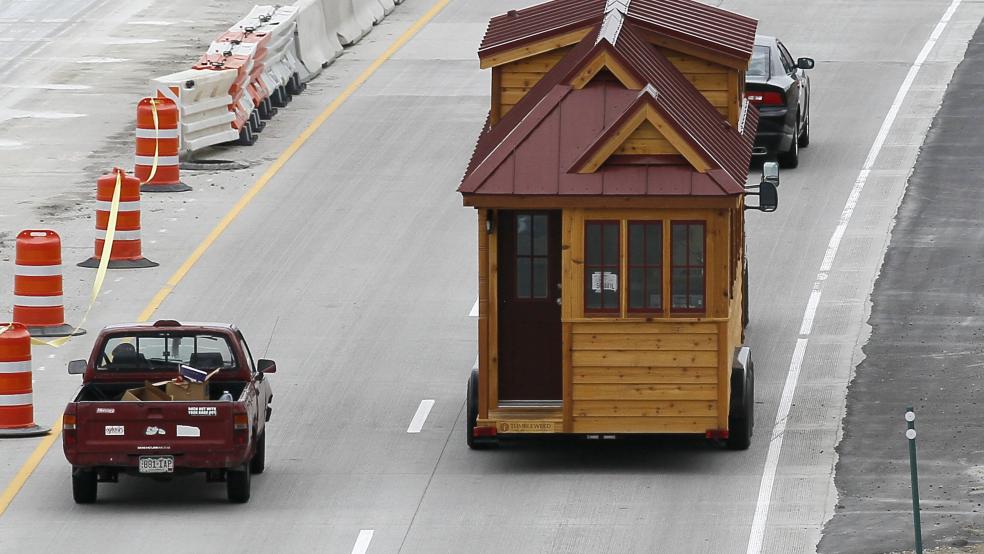The average size of a new home in the U.S. is 2,400 square feet. Imagine living in just one tenth of that space. That’s exactly what some people are doing as part of the tiny home movement that celebrates living with less, environmental awareness and fiscal sanity.
Tiny home living has gone mainstream largely due to growing media coverage – including TV shows such as Tiny Home Nation and Tiny Home Builders, countless blogs and conferences all over the country – that have glamorized this untraditional lifestyle, rather than significant growth in the market segment. The reality is that most people still want larger homes. The median size of a new home has increased more than 10 percent in the last decade and is 50 percent larger than in 1985.
Related: 3 Awesome Tiny Homes That Cost Less Than $45,000
So the adjustment to a wee lifestyle, especially after living large in a more traditional home, can sometimes be bumpy. To get through the transition, those who’ve done it have held onto certain big-home luxuries to keep their sanity.
“My husband and I became very aware how we used each room and space, so we could design [our tiny home] for the way we lived,” says Jody Brady of the Simply Enough blog. Brady, 59, went from a 3,500-square-foot house in Arlington, Virginia, to a 12-by-24-foot home in the Blue Ridge Mountains with her husband.
Design for you
One of the key decisions the Bradys made was to eschew a loft, a typical space-saving feature in tiny homes, and build a slightly bigger tiny house to accommodate a separate bedroom.
“We didn’t want to climb up a ladder. My husband is claustrophobic. The bedroom also provides separation,” she says. Brady also noted that the kitchen, which is often located underneath a sleeping loft in tiny homes, felt bigger with a ceiling that reaches 11 feet high thanks to the absence of a loft above.
In the kitchen, they opted for a huge sink, 33 inches wide, which Brady says seems “sort of ridiculous big, but feels very functional.”
Related: 10 Tiny but Luxurious Homes
The largest adjustment was in the bathroom, says Brady. “Now, we can have a really quality six-minute shower but, after that, the hot water runs out. And the composting toilet, people think it’s harder and scarier than it is. It just requires more work.”
Enough room for a family
Like the Bradys, Andrew and Gabriella Morrison of Ashland, Oregon, weren’t willing to sacrifice a full-sized kitchen in their 207-square-foot home. “Both of our kids have Celiac disease,” says Gabriella Morrison, so most of the family’s meals happens at home.
They also abandoned another tiny home standby, the ladder, as a way to get the master bedroom in a loft. Instead, they built a staircase that can be climbed easily and that also doubles as storage underneath.
For their 16-year-old daughter and 19-year-old son, the Morrisons built separate sleeping cabins, so the teenagers could have privacy. Their son has a 160-square-foot treehouse, while their daughter got a 120-square-foot elevated cabin. Both have power, but no plumbing.
Embrace the outdoors
The Bradys have found they spend more time outside now that they have a tiny home. They have built an impressive 420-square-foot deck surrounding their home, and a screened-in, single-room hut nearby. They are now working on building garden beds to enhance their outdoor living.
Related: How Much Does a Tiny House Really Cost?
Ethan Waldman also says the great outdoors helped his adjustment to itty-bitty living. Waldman, 31, lives in a 220-square-foot home on a lake in Morristown, Vermont, with his fiancée.
“We spend a lot of time outside. The house has so many windows, so you are looking outside all the time,” he says. “You make outside into your living space since there isn’t much living space inside.”
Outside resources
Waldman’s transition to small-scale living has been made easier because he only lives in this tiny home part time. He splits his time between his home and his fiancée’s 800-square-foot condo in Burlington, Vermont. He also stores his off-season clothes in a friend’s attic, reducing how much storage space he needs in his small home, and does laundry at his parent’s house nearby or at the condo.
Similarly, the Bradys use storage space and laundry facilities from the friend who rents them the land their home sits on. These small benefits can feel bigger when living in a tiny home.
Going from big to small
Making the tiny-home adjustment took advanced preparation. The Morrisons sold all of their belongings, bought a pop-up camper and moved their family to the Baja beaches in Mexico for several months.
Related: Tiny Homes Are Hot, and They’re Going Upscale
“The first month was literally hell and we almost turned back around. We were going through significant withdrawals from electronics, fast-paced life,” says Gabriella Morrison. But by the time they moved into their tiny home in Oregon, the adjustment had been made. “We had gone through that discomfort and unplugging process already,” she says.
The Bradys started downsizing gradually, moving from their large house to a one-bedroom apartment, which still felt too big. They slowly got rid of many of their belongings, keeping only those that they couldn’t bear to let go of.
“I say don’t do it all at once. I still have all my grandmother’s china and silver,” Brady says. “It’s not about giving up everything you love. It’s about deciding what you love and building a house and life to include those things.”
Click here to see the tiny homes of Ethan Waldman, the Bradys and the Morrisons.





